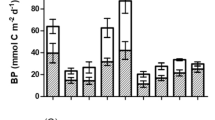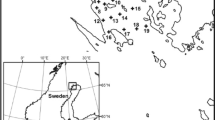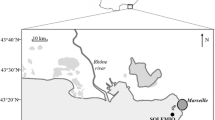Abstract
Dark carbon fixation (DCF) is considered an important energy source in aquatic environments, although it has been neglected for a long time. DCF is known to be relevant in ecosystems associated with redoxclines, shallow-water sulfide-rich habitats, deep-sea vents, cold seeps, and even in coastal waters associated with upwelling events. The aim of this study was to evaluate the relative importance of DCF in relation to heterotrophic bacterial production (BP), as well as how these rates affect each other, and how they are influenced by the environmental factors. This study was conducted monthly during 2 years in a tropical eutrophic bay (Guanabara Bay), where two stations were sampled and compared. DCF and BP were measured by 14C-bicarbonate and 3H-leucine incorporation, respectively, and incubations in the dark. Our results showed that DCF is not a quantitatively relevant process in this estuarine system, when compared to heterotrophic BP, and possibly occurred via anaplerotic reactions. Relatively higher DCF rates were associated with less oxygenated waters at the more polluted station and during the wet summer-spring, when the water column is more stratified. BP rates presented clear spatial patterns, according to pollution and depth gradients, with higher rates in more polluted areas, and also at surface waters. The hydrodynamics combined with other environmental conditions (precipitation, temperature, dissolved organic carbon, and nutrients) may control the distribution of DCF and BP over space and time. The allochthonous inputs of organic matter are more important than DCF-derived organic carbon to bacterioplankton in this polluted and eutrophic bay, where the heterotrophic metabolism prevails.






Similar content being viewed by others
References
Almeida, M.A., M.A. Cunha, and F. Alcântara. 2001. Factors influencing bacterial production in a shallow estuarine system. Microbial Ecology 42 (3): 416–426. https://doi.org/10.1007/s002480000119.
Almeida, M.A., M.A. Cunha, and J.M. Dias. 2007. Bacterial productivity distribution during a rainy year in an estuarine system. Microbial Ecology 53: 208. https://doi.org/10.1007/s00248-005-0082-6.
Alonso-Sáez, L., P.E. Galand, E.O. Casamayor, C. Pedrós-Alió, and S. Bertilsson. 2010. High bicarbonate assimilation in the dark by Arctic bacteria. The ISME Journal 4: 1581–1590. https://doi.org/10.1038/ismej.2010.69.
Alves Junior, N., P.M. Meirelles, E. de Oliveira Santos, B. Dutilh, G.G. Silva, R. Paranhos, A.S. Cabral, C. Rezende, T. Iida, et al. 2015. Microbial community diversity and physical-chemical features of the Southwestern Atlantic Ocean. Arch Microbiol 197 (2): 165–179. https://doi.org/10.1007/s00203-014-1035-6.
Amador, E.S. 1997. Baía de Guanabara e ecossistemas periféricos: homem e natureza, 539. Rio de Janeiro: Reproarte.
Aminot, A., and M. Chaussepied. 1983. Manuel des analyses chimiques en milieu marin, 395. Brest: Centre National pour l’Éxploration des Océans.
Anderson, M.J. 2001. A new method for non-parametric multivariate analysis of variance. Aust Ecol, 26: 32–46. https://doi.org/10.1111/j.1442-9993.2001.01070.pp.x
Andersson, M.G.I., N. Brion, and J.J. Middelburg. 2006. Comparison of nitrifier activity versus growth in the Scheldt estuary—A turbid, tidal estuary in northern Europe. Aqua Microb Ecol, vol. 42: 149–158. https://doi.org/10.3354/ame042149.
APHA, American Public Health Association. 1998. Microbiological examination. p.1–140. In: Standard methods for the examination of water and wastewater. 20th ed, 160ESM 0. Washington D.C., DC: APHA, AWWA, WEF.
Azam, F., and B. C. Cho 1987. Bacterial utilization of organic matter in the sea. In: M. Fletcher M, T. R. G. Gray, and J. G. Jones (eds.) Ecology of microbial communities, 261–281. Cambridge: Cambridge University Press.
Baltar, F., D. Lundin, J. Palovaara, I. Lekunberri, T. Reinthaler, G.J. Herndl, and J. Pinhassi. 2016. Prokaryotic responses to ammonium and organic carbon reveal alternative CO2 fixation pathways and importance of alkaline phosphatase in the mesopelagic North Atlantic. Frontiers in Microbiology 7: 1670. https://doi.org/10.3389/fmicb.2016.01670.
Barrera-Alba, J.J., S.M.F. Gianesella, G.A.O. Moser, and F.M.P. Saldanha-Corrêa. 2008a. Bacterial and phytoplankton dynamics in a sub-tropical estuary. Hydrobiologia 598: 229–246. https://doi.org/10.1007/s10750-007-9156-4.
Barrera-Alba, J.J., S.M.F. Gianesella, G.A.O. Moser, and F.M.P. Saldanha-Corrêa. 2008b. Influence of allochthonous organic matter on bacterioplankton biomass and activity in a eutrophic, sub-tropical estuary. Estuarine, Coastal and Shelf Science 82: 84–94. https://doi.org/10.1016/j.ecss.2008.12.020.
Bastviken, D., J. Ejlertsson, I. Sundh, and L. Tranvik. 2003. Methane as a source of carbon and energy for lake pelagic food webs. Ecology 84: 969–981. https://doi.org/10.1890/0012-9658(2003)084[0969:MAASOC]2.0.CO;2.
Bauer, J.E., C. Wein-Jun, P.A. Raymond, T.S. Bianchi, C.S. Hopkinson, and P.A.G. Regnier. 2013. The changing carbon cycle of the coastal ocean. Nature 504: 61–70. https://doi.org/10.1038/nature12857.
Bérgamo, A.L. 2006. Características Hidrográficas, da Circulação e dos Transportes de Volume e Sal na Baía de Guanabara (RJ): Variações sazonais e Moduladas pela Maré. Tese de Doutorado: Instituto Oceanográfico, Universidade de São Paulo.
Braga, E. S., and L. F. H. Niencheski. 2006. Composição das massas de água e seus potenciais produtivos na área entre o Cabo de São Tomé (RJ) e o Chuí (RS). In: C. L. Rossi-Wongtschowski, and L. ESM S.-P. Madureira (eds.), O ambiente oceanográfico da plataforma continental e do talude na região sudeste-sul do Brasil, 161–218. São Paulo: Edusp.
Brandini, F.P. 1990. Hydrography and characteristics of the phytoplankton in shelf and oceanic waters off southeastern Brazil during winter (July/August 1982) and summer (February/March 1984). Hydrobiologia 196: 111–148.
Bräuer, S.L., K. Kranzler, N. Goodson, D. Murphy, H.M. Simon, A.M. Baptista, and B.M. Tebo. 2013. Dark carbon fixation in the Columbia River’s estuarine turbidity maxima: Molecular characterization of red-type cbbL genes and measurement of DIC uptake rates in response to added electron donors. Estuarine, Coastal and Shelf Science 36 (5): 1073–1083.
Cai, W.-J. 2011. Estuarine and coastal ocean carbon paradox: CO2 sinks or sites of terrestrial carbon incineration? Annual Review of Marine Science 3: 123–145. https://doi.org/10.1146/annurev-marine-120709-142723.
Campbell, B.J., and D.L. Kirchman. 2013. Bacterial diversity, community structure and potential growth rates along an estuarine salinity gradient. The ISME Journal 7: 210–220.
Carmouze, J.P. 1994. O metabolismo dos ecossistemas aquáticos: fundamentos teóricos, métodos de estudo e análises químicas, 253. São Paulo: Edgar Blucher: FAPESP.
Casamayor, E.O., J. García-Cantizano, J. Mas, and C. Pedrós-Alió. 2001. Microbial primary production in marine oxic/anoxic interfaces: Main role of dark fixation in the Ebro River salt wedge estuary. Marine Ecology Progress Series 215: 49–56.
Casamayor, E.O., J. García-Cantizano, and C. Pedrós-Alió. 2008. Carbon dioxide fixation in the dark by photosynthetic bacteria in sulfide-rich stratified lakes with oxic-anoxic interfaces. Limnology and Oceanography 53 (4): 1193–1203. https://doi.org/10.4319/lo.2008.53.4.1193.
Castro, B. M., J. A. Lorenzzetti, I. C. A. Silveira, and L. B. Miranda. 2006a. Estrutura termohalina e circulação na região entre o Cabo de São Tomé (RJ) e o Chuí (RS). In: C. L. B. Rossi-Wongtschowski, and L. S.-P. Madureira, L.S.-P. (eds.), O Ambiente Oceanográfico da Plataforma Continental e do Talude na Região Sudeste-Sul do Brasil, 11–120. São Paulo: Edusp.
Castro, B. M., F. P. Brandini, A. M. Pires-Vanin, and L. B. Miranda. 2006b. Multidisciplinary oceanographic processes on the Western Atlantic continental shelf between 4°N and 34°S (4, W). In: Robinson, R., and K. H. Brink (eds.), The sea, vol. 14, The global coastal ocean: Interdisciplinary regional studies and syntheses, 259–293. Cambridge: Harvard University Press.
Cole, J.J., S. Findlay, and M.L. Pace. 1988. Bacterial production in fresh and saltwater ecosystems: A cross-system overview. Marine Ecology Progress Series 43: 1–10.
CONAMA, Conselho Nacional Do Meio Ambiente. 2000. Ministério do Meio Ambiente. Resolução n. 274 de 29 de novembro de 2000. Brasília, DF: Diário Oficial da República Federativa do Brasil, Poder Executivo.
CONAMA, Conselho Nacional Do Meio Ambiente. 2005. Ministério do Meio Ambiente. Resolução n. 357 de 17 de março de 2005. Brasília, DF: Diário Oficial da República Federativa do Brasil, Poder Executivo.
de Aguiar, V.M.C., J.A.B. Neto, and C.M. Rangel. 2011. Eutrophication and hypoxia in four streams discharging in Guanabara Bay, RJ, Brazil, a case study. Marine Pollution Bulletin 62: 1915–1919. https://doi.org/10.1016/j.marpolbul.2011.04.035.
Detmer, A.E., H.C. Giesenhagen, V.M. Trenkel, H. Venne, and F.J. Jochem. 1993. Phototrophic and heterotrophic pico and nanoplankton in anoxic depths of the central Baltic Sea. Marine Ecology Progress Series 99: 197–203.
Ducklow, H.W. 2000. Bacterial production and biomass in the oceans. In Microbial ecology of the oceans, ed. D.L. Kirchman, 85–120. New York: John Wiley & Sons.
Dyer, K.R. 1997. Estuaries: A physical introduction, 195. West Sussex: John Wiley and Sons.
Enrich-Prast A., D. Bastviken, P. Crill, A. L. Santoro, C. N. Signori, and A. M. Sanseverino. 2014. Chemosynthesis. In: Reference module in earth systems and environmental sciences. Elsevier. https://doi.org/10.1016/B978-0-12-409548-9.09054-0
Fistarol, G.O., F.H. Coutinho, A.P.B. Moreira, T. Venas, A. Cánovas, S.E.M. de Paula, et al. 2015. Environmental and sanitary conditions of Guanabara Bay, Rio de Janeiro. Frontiers in Microbiology 6: 1232. https://doi.org/10.3389/fmicb.2015.01232.
Fonseca, E.M., J.A. Baptista Neto, C.G. Silva, J.J. McAllister, B.J. Smith, and M.A. Fernandez. 2013. Stormwater impact in Guanabara Bay (Rio de Janeiro): Evidences of seasonal variability in the dynamic of the sediment heavy metals. Estuarine, Coastal and Shelf Science 130: 161–168. https://doi.org/10.1016/j.ecss.2013.04.022.
Fortunato, C.S., L. Herfort, P. Zuber, A.M. Baptista, and B.C. Crump. 2012. Spatial variability overwhelms seasonal patterns in bacterioplankton communities across a river to ocean gradient. The ISME Journal 6: 554–563.
Gilbert, J.A., J.A. Steele, J.G. Caporaso, L. Steinbruck, J. Reeder, B. Temperton, et al. 2012. Defining seasonal marine microbial community dynamics. The ISME Journal 6: 298–308.
Glaubitz, S., T. Luerders, W.-R. Abraham, G. Jost, K. Jürgens, and M. Labrenz. 2009. 13C-isotope analyses reveal that chemolithoautotrophic Gamma- and Epsilonproteobacteria feed a microbial food web in a pelagic redoxcline of the central Baltic Sea. Environmental Microbiology 11 (2): 326–337. https://doi.org/10.1111/j.1462-2920.2008.01770.x.
Gonzalez, A.M., R. Paranhos, L. Andrade, and J.L. Valentin. 2000. Bacterial production in Guanabara Bay (Rio de Janeiro, Brazil) evaluated by 3H-leucine incorporation. Braz. Arch. Biol. Techn. 43 (5): 493–500. https://doi.org/10.1590/S1516-89132000000500008.
Gregoracci, G.B., J.R. Nascimento, A.S. Cabral, R. Paranhos, J.L. Valentin, C.C. Thompson, and F.L. Thompson. 2012. Structuring of bacterioplankton diversity in a large tropical bay. PlosOne 7 (2): e31408. https://doi.org/10.1371/journal.pone.0031408.
Griffith, G.E., J.M. Omernik, T.F. Wilton, and S.M. Pierson. 1994. Ecoregions and subregions of Iowa: A framework for water quality assessment and management. JIAS 101 (1): 5–13.
Guenther, M., and J.L. Valentin. 2008. Bacterial and phytoplankton production in two coastal systems influenced by distinct eutrophication processes. Oecol. Bras. 12 (1): 172–178.
Guenther, M., R. Paranhos, C. Rezende, E. Gonzalez-Rodriguez, and J.L. Valentin. 2008. Dynamics of bacterial carbon metabolism at the entrance of a tropical eutrophic bay influenced by tidal oscillation. Aquatic Microbial Ecology 50: 123–133. https://doi.org/10.3354/ame01154.
Herndl, G.J., T. Reinthaler, E. Teira, H. van Aken, C. Veth, et al. 2005. Contribution of Archaea to total prokaryotic production in the deep Atlantic Ocean. Applied and Environmental Microbiology 71: 2303–2309. https://doi.org/10.1128/AEM.71.5.2303-2309.2005.
Hoch, M.P., and D.L. Kirchman. 1993. Seasonal and inter-annual variability in bacterial biomass and production in a temperate estuary. Marine Ecology Progress Series 98: 283–296.
JICA. Japan International Cooperation Agency. 1994. The study on recuperation of the Guanabara bay ecosystem v. 3, Supporting Report, 537. Tokyo: Kokusai Kogyo Co. Ltd.
Jørgensen, B.B., H. Fossing, C.O. Wirsen, and H.W. Jannasch. 1991. Sulfide oxidation in the anoxic Black Sea chemocline. Deep Sea Research 38: S1083–S1103.
Jost, G., M.V. Zubkov, E. Yakushev, M. Labrenz, and K. Jürgens. 2008. High abundance and dark CO2 fixation of chemolithoautotrophic prokaryotes in anoxic water of the Baltic Sea. Limnology and Oceanography 53: 14–22.
Kelly, J.R., and S.A. Levin. 1986. A comparison of aquatic and terrestrial nutrient cycling and production processes in natural ecosystems, with reference to ecological concepts of relevance to some waste disposal issues. In The role of the oceans as a waste disposal option, ed. C.C. Kullenberg, 165–203. New York: D Reidel Publ CO.
Kemp, W.M., E.M. Smith, M. Marvin-DiPasquale, and W.R. Boynton. 1997. Organic carbon-balance and net ecosystem metabolism in Chesapeake Bay. Marine Ecology Progress Series 150: 229–248.
Kirchman, D. L. 2012. Processes in microbial ecology, 312. Oxford: Oxford University Press.
Kirchman, D.L., E. K’ness, and R.E. Hodson. 1985. Leucine incorporation and its potential as a measure of protein synthesis by bacteria in natural aquatic systems. Applied and Environmental Microbiology 49: 599–607.
Kirchman, D.L., A.I. Dittel, R.R. Malmstrom, and M.T. Cottrell. 2005. Biogeography of major bacterial groups in the Delaware estuary. Limnology and Oceanography 50: 1697–1706.
Kjerfve, B., C. Ribeiro, G. Dias, A. Filippo, and V. Quaresma. 1997. Oceanographic characteristics of an impacted coastal bay: Baía de Guanabara, Rio de Janeiro. Braz. Cont. Shelf Res 17: 1609–1643.
Labrenz, M., G. Jost, C. Pohl, S. Beckmann, W. Martens-Habbena, and K. Jürgens. 2005. Impact of different in vitro electron donor/acceptor conditions on potential chemolithoautotrophic communities from marine pelagic redoxclines. Applied and Environmental Microbiology 71: 6664–6672. https://doi.org/10.1128/AEM.71.11.6664-6672.2005.
Mayr, L., D.R. Tenenbaum, M.C. Villac, R. Paranhos, C. Nogueira, S. Bonecker, and A. Bonecker. 1989. Hydrobiological characterization of Guanabara Bay. In Coastlines of Brazil, ed. O. Magoon and C. Neves, 124–138. New York: American Society of Civil Engineers.
McLusky, D.S. 1989. The estuarine ecosystem, 215 p. Glasgow: Chapman & Hall.
Miranda, L.B., B.M. Castro, and B. Kjerfve. 2002. Princípios de Oceanografia física de estuários. São Paulo: Edusp 414 p.
Paranhos, R., and L. Mayr. 1993. Seasonal patterns of temperature and salinity in Guanabara Bay, Brasil. Fresenius Environ. Bull. 2: 647–652.
Patel, A., K. Fukami, and T. Nishima. 2000. Regulation of seasonal variability of aminopeptidase activities in surface and bottom waters of Uranouchi Inlet. Aquatic Microbial Ecology 21: 139–149.
Perner, M., J.M. Petersen, F. Zielinski, H.H. Gennerich, and R. Seifert. 2010. Geochemical constraints on the diversity and activity of H2-oxidizing microorganisms in diffuse hydrothermal fluids from a basalt- and an ultramafic-hosted vent. FEMS Microbiology Ecology 74: 55–71.
Pomeroy, L.R., J.E. Sheldon, W.M. Jr, and F. Peters. 1995. Limits to growth and respiration of bacterioplankton in the Gulf of Mexico. Marine Ecology Progress Series 117: 259–268.
Preen, K., and D.L. Kirchman. 2004. Microbial respiration and production in the Delaware Estuary. Aquatic Microbial Ecology 37: 109–119.
Reinthaler, T., H.M. van Aken, and G.J. Herndl. 2010. Major contribution of autotrophy to microbial carbon cycling in the deep North Atlantic’s interior. Deep Sea Res. Part II Top. Stud. Oceanogr 57: 1572. https://doi.org/10.1016/j.dsr2.2010.02.023.
Revilla, M., A. Iriarte, I. Madariaga, and E. Orive. 2000. Bacterial and phytoplankton dynamics along a trophic gradient in a shallow temperate estuary. Estuarine, Coastal and Shelf Science 50: 297–313. https://doi.org/10.1006/ecss.1999.0576.
Romanenko, V.I. 1964. Heterotrophic assimilation of CO2 by bacterial flora of water. Mikrobiologiya 33: 610–613.
Santoro, A.L., D. Bastviken, C. Gudasz, L. Tranvik, and A. Enrich-Prast. 2013. Dark carbon fixation: An important process in lake sediments. PLoS One 8 (6): 1–7. https://doi.org/10.1371/journal.pone.0065813.
Schultz, G., E. White, and H.W. Ducklow. 2003. Bacterioplankton dynamics in the York River estuary: Primary influence of temperature and freshwater inputs. Aquatic Microbial Ecology 30: 135–148. https://doi.org/10.3354/ame030135.
Schultz, G.E., and H.W. Ducklow. 2000. Changes in bacterioplankton metabolic capabilities along a salinity gradient in the York River estuary, Virginia, USA. Aquatic Microbial Ecology 22: 163–174.
Schumann, R., T. Rieling, S. Gors, A. Hammer, U. Selig, and U. Schiewer. 2003. Viability of bacteria from different aquatic habitats. I. Environmental conditions and productivity. Aquatic Microbial Ecology 32: 121–135.
Sharp, J.H., K. Yoshiyama, A.E. Parker, M.C. Schwartz, S.E. Curless, A.Y. Beauregard, et al. 2009. A biogeochemical view of estuarine eutrophication: Seasonal and spatial trends and correlations in the Delaware Estuary. Estuar. Coast. 32: 1023–1043.
Simon, M., and F. Azam. 1989. Protein content and protein synthesis rates of planktonic marine bacteria. Marine Ecology Progress Series 51: 201–213.
Smith, D.C., and F. Azam. 1992. A simple, economical method for measuring bacterial protein synthesis rates in seawater using 3H-leucine. Marine Microbial Food Webs 6: 107–114.
Sorokin, D.Y. 1993. Influence of thiosulfate on activity of carbon dioxide assimilation by marine heterotrophic thiosulfate-oxidizing bacteria. Microbiology 62: 488–493.
Steemann-Nielsen, E. 1952. The use of radio-active carbon (14C) for measuring organic production in the sea. J. Cons. Int. Explor. Mer. 18: 117–140.
Stramma, L., and M. England. 1999. On the water masses and mean circulation of the South Atlantic Ocean. Journal of Geophysical Research 104 (9): 863–883.
Taylor, G.T., M. Iabichella, T.Y. Ho, M.I. Scranton, R.C. Thunell, F. Muller-Karger, and R. Varela. 2001. Chemoautotrophy in the redox transition zone of the Cariaco Basin: A significant midwater source of organic carbon production. Limnology and Oceanography 46: 148–163.
Telesh, I.V., and V.V. Khlebovich. 2010. Principal processes within the estuarine salinity gradient: A review. Marine Pollution Bulletin 61: 149–155.
Valentin, J.L. 2001. The Cabo Frio upwelling system, Brazil. In Coastal marine ecosystems of Latin America, ed. U. Seeliger and B. Kjerfve, 97–105. Berlin: Springer-Verlag.
Valentin, J.L., D.R. Tenenbaum, A.C.T. Bonecker, S.L.C. Bonecker, C.R. Nogueira, R. Paranhos, and M.C. Villac. 1999. Caractéristiques hydrobiologiques de la baie de Guanabara (Rio de Janeiro, Brésil). J. Rech. Ocean. 24: 33–41.
Villac, M.C., and D.R. Tenenbaum. 2010. The phytoplankton of Guanabara Bay, Brazil. Biota Neotropica 10 (2): 271–293.
Welschmeyer, N.A. 1994. Fluorometric analysis of chlorophyll a in the presence of chlorophyll b and pheopigments. Limnology and Oceanography 39 (8): 1985–1992.
Acknowledgements
We thank Francisco Matos “Xikão” and many students for their assistance in field sampling, as well as Bruno C. Rego, Luísa O. Dantas and Tainá M.M. Souza for helping to analyze the samples at the Lab of Biogeochemistry (UFRJ). We also thank Prof. Denise Tenenbaum and Prof. Margaretha D.M. van Weerelt for gently sharing the chlorophyll-a and Enterococcus data, respectively. Special thanks to Prof. Jean R.D. Guimarães for providing fundamental guidance on the liquid scintillation analyses. This work was supported by the Brazilian National Counsel of Technological and Scientific Development—CNPq (PELD-Guanabara Project 403809/2012-6 and INCT-Mar-COI) and Research Support Foundation of the State of Rio de Janeiro-FAPERJ (Programa Temático, Process E-26/110114/2013). Alex Enrich-Prast is a researcher fellow from CNPq and “Cientista do Nosso Estado” from the Foundation for Support of Research in the State of Rio de Janeiro-FAPERJ. Camila N. Signori was supported by CNPq Ph.D. fellowship (process number 142848/2010-7) when this research has started, and currently receives a Post Doc fellowship from The São Paulo Research Foundation (FAPESP 2016/16183-5).
Author information
Authors and Affiliations
Corresponding author
Ethics declarations
Conflict of Interest
The authors declare that they have no conflict of interest.
Additional information
Communicated by Margaret R. Mulholland
Rights and permissions
About this article
Cite this article
Signori, C.N., Valentin, J.L., Pollery, R.C.G. et al. Temporal Variability of Dark Carbon Fixation and Bacterial Production and Their Relation with Environmental Factors in a Tropical Estuarine System. Estuaries and Coasts 41, 1089–1101 (2018). https://doi.org/10.1007/s12237-017-0338-7
Received:
Revised:
Accepted:
Published:
Issue Date:
DOI: https://doi.org/10.1007/s12237-017-0338-7




